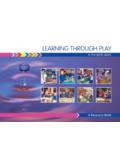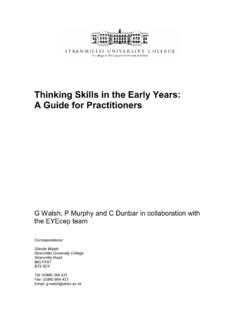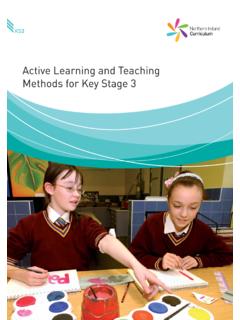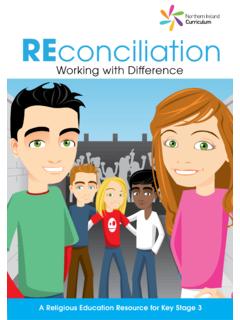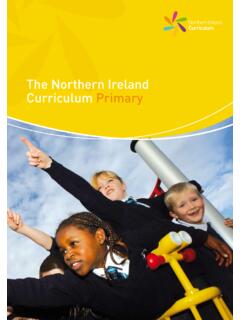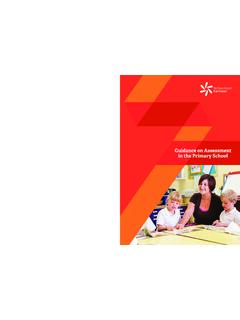Transcription of (PDF) Gifted and talented children in (and out) of the ...
1 Gifted and talented children in ( and out ) of the classroom A report for the Council of Curriculum, Examinations and Assessment (CCEA) Feb 28th 2006 Gifted and talented children in ( and out ) of the classroom 1 A report for the Council of Curriculum, Examinations and Assessment (CCEA) 1 Feb 28th 2006 What does it mean to be Gifted / talented ? 1 What does it mean to be Gifted / talented ? 6 Definitions of giftedness and talent 6 Giftedness versus talent 6 Categories of definitions of giftedness 8 Identifying Gifted and talented students 9 General Characteristics of Gifted , talented and More Able Pupils. 11 Parent s reports 12 Peer nominations and self-report. 12 Why provide for Gifted and talented students?
2 13 The concept of intelligence 14 Renzulli s Three-Ring Model 14 Gardner s Theory of Multiple Intelligences 18 What Learners Like To Do 20 Interpersonal 20 Intrapersonal 20 Bodily-Kinaesthetic 20 Linguistic 21 Musical 21 Sternberg s triarchic model of intelligence 22 Provision for Gifted / talented children within the regular classroom 23 Curriculum Differentiation 23 Enrichment 23 Extension 23 Acceleration 24 Competitions 27 Mentoring 27 2 Ten approaches to differentiation 28 Ten ways to encourage challenge in children s learning 30 Bloom s Taxonomy of Educational Objectives (Bloom, 1956) 32 A teacher s guide to structuring activities and asking questions using Bloom s Taxonomy 34 Ideas and Suggestions for Challenging Extension and Enrichment activities 38 Using Questions to promote effective learning and critical thinking 43 The Tic-Tac-Toe task choice menu 45 Providing challenge for Gifted / talented students 47 What is challenge?
3 47 What kind of challenge is appropriate? 47 Social and Emotional issues in the development of Gifted children 49 Self-concept, self-esteem, social adjustment and identity 50 Subtypes of giftedness from a socio-emotional viewpoint 51 Emotional Giftedness: Overexcitability and Extreme sensitivity. 52 Family Relationships for Gifted and talented children 54 Relationships with siblings 54 Managing Stress in Gifted and talented children 55 Career planning and support for Gifted / talented children 57 Underachievement in Gifted and talented children 58 Primary Characteristic of underachievers: Low self-esteem 59 secondary Characteristics of underachievers: Avoidance Behaviour. 59 Tertiary Characteristics of Underachievers 61 The effects of culture and socio-economic class on giftedness and talent 64 The Twice Exceptional Child.
4 Gifted and talented children with Disabilities 65 Gifted children with ADHD 66 Gifted children with Asperger s Syndrome 69 Gifted and talented children with Learning Difficulties and Dyslexia 70 Gifted and talented children with sensory and motor impairments 72 International Provision for Gifted and talented Students 75 3 Gifted and talented Education in North America and Canada 76 North America 76 The Talent Search Model 77 Centre for talented Youth (CTY) 78 On- and above-level testing 78 Davidson Institute for Talent Development 79 The Apex Program 81 Advanced Placement 81 Canada 82 Gifted and talented Education in the United Kingdom and Republic of Ireland. 84 England 84 Excellence in Cities (EiC) 85 Physical Education, School Sport and Club Links Strategy Gifted and talented Strand 86 Multi-skill Clubs 87 The National Academy for Gifted and talented Youth 87 Other approaches: 97 Villiers Park 97 The Brunel Able children 's Education (BACE) Centre 97 Wales: 99 Scotland 100 Scottish Network for Able Pupils (SNAP) 100 Northern Ireland 101 Republic of Ireland.
5 101 IBM/DCU Irish Science Olympiad 101 Irish Centre for talented Youth (CTYI) 102 Gifted and talented Education in Asia 104 China 104 Japan 105 Gifted and talented Education in the Antipodes 106 Australia 106 New Zealand 108 Gifted and talented in Europe 109 Spain 109 Hungary 110 Scandinavia 111 Russia 112 References 113 4 Appendix 1 Information on Gifted and talented Education on the World Wide Web and in print 119 Gifted and talented on the World Wide Web 119 Associations, Publications and CPD 119 Associations 119 Global 119 United Kingdom 119 Ireland 119 United States 119 Canada 120 Australia 120 New Zealand 121 Teacher CPD 122 Appendix 2 List of extra - curricular activities and enrichment ideas available on the World Wide Web for Gifted and talented Students 123 5 What does it mean to be Gifted / talented ?
6 Identification of the Gifted and talented can pose a problem to teachers and education professionals because they are not a homogeneous group. The typical picture of the highly able child is of a hard-working pupil who diligently completes work, and is perhaps known as the class swot or brain box . In reality the picture is much more complex than that. Alongside the Gifted achievers are those who - despite their gifts and talents - persistently underachieve due to boredom, lack of interest, or crippling perfectionism; young children who are cognitively advanced enough to play games with complex rule structures and yet not socially mature enough to deal with the frustration that occurs when their peers cannot grasp the game; children whose giftedness may be masked by the fact that they are not being educated in their first language or who have also have a disability.
7 The vast number of definitions for giftedness and talent can be quite confusing. We have provided some of the better known definitions in the section below in order to give you an overview of the area. No one definition is perfect highly able children can no more be fitted into one neat category box than any other child whose range of experiences has shaped his or her attitudes to learning and achievement. Definitions of giftedness and talent Before beginning to develop provision for Gifted and talented students it is necessary to understand just what is meant by these terms, and how they apply to children in our classrooms. There is large variation in the range and breadth of definitions of Gifted and talented students, and little consensus on a satisfactory definition.
8 This lack of clarity led Gagne to remark that the concept of giftedness is at times difficult to defend because it is defined too loosely while being measured too restrictively (Gagne, 1995, pp 104). Giftedness versus talent Originally the words Gifted and talented were often used interchangeably, or at times the concept of talent was seen as being in some way lesser compared with the idea of giftedness. For example Morelock (1996) referred to a hierarchical categorisation 6with talent referring to specialised aptitudes that are assumed to be unrelated and inferior - to general intelligence and giftedness. In the mid 1990 s, the term talented was often used to replace Gifted , which was thought to have connotations of getting something for nothing , or being specially chosen in some way.
9 Freeman (2000) and Winstanley (2004) both comment that the term Gifted often seems to have religious overtones of gifts bestowed by God. Winstanley also remarks that this also implies moral connotations to do with being Gifted , as if the child has a responsibility to apply themselves and not waste their abilities. The term able and variations of it are used frequently in the educational literature as it is felt to be more appropriate and less emotive. In both Wales and Scotland pupils are classified as More Able and talented and Able respectively. Winstanley (2004) notes that the term able is often prefixed by words such as more , very , severely or profoundly , in order to create subtle distinctions that are often neither objective nor useful.
10 She advocates using the term highly able for the majority of able pupils and exceptionally able for those who are particularly outstanding. However, the terms Gifted and talented are those that are used most frequently in government strategies and research literature and so will be used in the rest of this review. In this report the terms are not intended to be synonymous, and are defined separately. Gagn (1991) differentiated between the concepts of Gifted and talented by defining giftedness as above-average competence in human ability, and talent as above-average performance in a particular field. Giftedness refers to human aptitudes such as intellectual or creative abilities.
